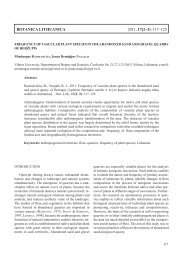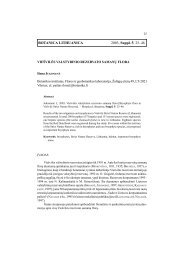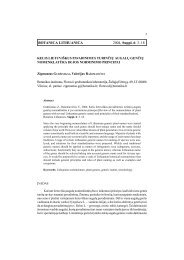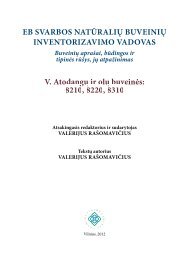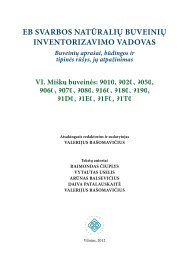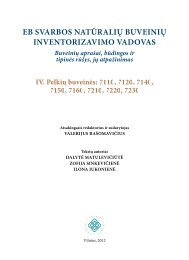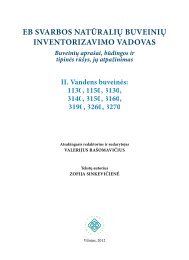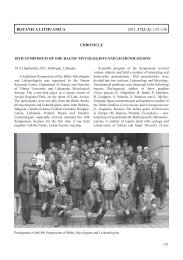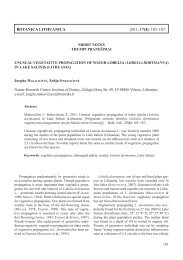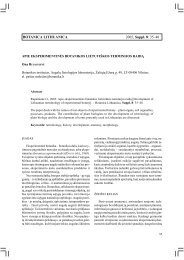FUNGI AND LICHENS IN THE BALTICS AND BEYOND XVIII ...
FUNGI AND LICHENS IN THE BALTICS AND BEYOND XVIII ...
FUNGI AND LICHENS IN THE BALTICS AND BEYOND XVIII ...
You also want an ePaper? Increase the reach of your titles
YUMPU automatically turns print PDFs into web optimized ePapers that Google loves.
Flörke, C. portentosa (Dufour) Coem., C. scabriuscula (Delise in Duby) Nyl., Hypogymnia<br />
bitteri (Lynge) Ahti, Melanohalea elegantula (Zahlbr.) O. Blanco, A. Crespo, Divakar, Essl., D.<br />
Hawksw. et Lumbsch, Protoparmelia nephaea (Sommerf.) R. Sant., Varicellaria carneonivea<br />
(Anz.) Erichs.<br />
41 species were found for the first time in Samara Region (Шустов, 2007; Корчиков,<br />
2009, 2010): Absconditella lignicola Vezda et Pisut, Arthonia dispersa (Schrad.) Nyl., A.<br />
mediella Nyl., A. radiata (Pers.) Ach., Bacidia beckhausii Körb., B. polychroa (Th. Fr.) Körb., B.<br />
subincompta (Nyl.) Arnold, Calicium viride Pers., Caloplaca cerinelloides (Erichs.) Poelt, C.<br />
transcaspica (Nyl.) Zahlbr., Candelaria concolor (Dicks.) Stein., Candelariella reflexa (Nyl.)<br />
Lettau, Chaenotheca ferruginea (Turner ex Sm.) Mig., C. furfuracea (L.) Tibell, C. laevigata<br />
Nádv., C. stemonea (Ach.) Müll. Arg., C. trichialis (Ach.) Th. Fr., Chaenothecopsis pusilla<br />
(Ach.) A. F. W. Schmidt, C. rubescens Vain., Cladonia gracilis (L.) Willd., Coenogonium pineti<br />
(Schrad. ex Ach.) Lücking et Lumbsch, Cyphelium tigillare (Ach.) Ach., Diplotomma alboatrum<br />
(Hoffm.) Flot., Eopyrenula leucoplaca (Wallr.) R. C. Harris, Graphis scripta (L.) Ach., Julella<br />
fallaciosa (Stizenb ex Arnold) R. C. Harris., Lecanora leptyrodes (Nyl.) Degel., Lecidella<br />
elaeochroma (Ach.) M. Choisy, Micarea denigrata (Fr.) Hedl., M. misella (Nyl.) Hedl., M.<br />
peliocarpa (Anzi) Coppins et R. Sant., Mycocalicium subtile (Pers.) Szatala, Ochrolechia<br />
pallescens (L.) A. Massal., Pachyphiale fagicola (Hepp) Zwackh, Pertusaria coccodes (Ach.)<br />
Nyl., P. hymenea (Ach.) Schaer., Piccolia ochrophora (Nyl.) Hafellner, Platismatia glauca (L.)<br />
W. L. Culb. et C. F. Culb., Staurothele frustulenta Vain., S. levinae Oxn., Usnea scabrata Nyl.<br />
DIVERSITY OF EPIPHYTIC <strong>LICHENS</strong> OF <strong>THE</strong> OAK-HORNBEAM FOREST <strong>IN</strong><br />
<strong>THE</strong> OLSZTYN LAKEL<strong>AND</strong> (N POL<strong>AND</strong>)<br />
D. KUBIAK<br />
Department of Mycology, Warmia and Mazury University in Olsztyn, Oczapowskiego 1A,<br />
PL-10-719 Olsztyn, Poland<br />
E-mail: darku@uwm.edu.pl<br />
Epiphytic lichen cover and diversity were analysed in the oak-hornbeam forest in the<br />
Olsztyn Lakeland. The mesoregion, covering ca. 4,000 km 2 , is located in the northern Poland,<br />
in the impact zone of sub-oceanic and sub-continental climates. Thirty study sites, with the<br />
constant area of 400m 2 , were sampled in the best preserved old-growth forest stand, situated<br />
both within protected areas, with the nature reserve status, as well as within managed forests.<br />
The sites were concentrated in three locations in the region (S, N and NE). At each site, all<br />
lichen species on each tree up to a height of 2 m were identified. A total of 405 trees,<br />
belonging to eleven tree species, were studied. A total of 130 lichen species were identified,<br />
with a range between 17 and 58 species per site (average 45). The highest number was<br />
recorded on Carpinus betulus with 103 species, followed by Quercus robur with 86 species,<br />
Acer platanoides with 52, Tilia cordata with 50, and Fagus sylvatica with 37 species. Most of<br />
the recorded lichens (80%) were crustose (104 taxa), while only 26 foliose and fruticose<br />
species were recorded. The common lichen species were 19 taxa (occurring in 80% of the<br />
sites), whilst the rare species (occurring in 20% of the sites) were 65 taxa. Out of the reported<br />
species, 43% of the taxa (57 species) are red-listed, 12% are protected by law in Poland (15<br />
species), and 25 species are considered to be the lichens-indicators of lowland old-growth<br />
forest in Poland. Particularly noteworthy collections include: Caloplaca lucifuga,<br />
Candelariella efflorescens, Cliostomum griffithii, Phaeophyscia endophoenicea and Pyrenula<br />
laevigata. The results could provide a reference point (in a regional and supra-regional scale)<br />
and a practical tool, both in assessing the state of conservation of lichen biota, as well as the<br />
degree of transformation of meso-and eutrophic deciduous forests. It seems to be particularly



